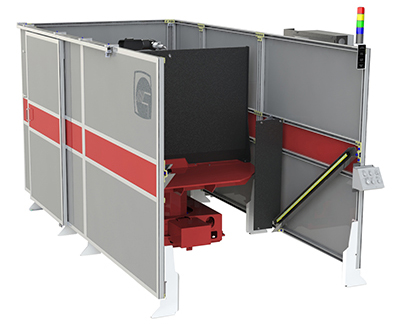The Importance of Choosing the Perfect Workcell for Automated Robotics

With the growing popularity of collaborative robots, people are becoming more and more comfortable with robots and robotic automation. But you might wonder, why are some devices still contained in workcells for automated robotics? Are those robots more dangerous than others? Not necessarily. With the right robotics workcells and proper training, your staff is as safe as ever.
What Workcells for Automated Robotics Accomplish
Robotics workcells were created for a few purposes. One reason is to protect human workers. Automated systems are constructed of heavy components and can move at speeds that could injure humans if the two should collide. Robots also lift heavy materials and objects. There is sometimes danger of material being dropped on an employee.
Another benefit of having workcells for automated robotics is so the robot is not interrupted while doing its work. Not all workers in a facility may be properly trained on the robot. Some safety systems slow or stop a robot when it is approached. Putting the robot in a workcell keeps humans at a safe distance and lets the robot do its job at full speed.
Designing the Best Robotics Workcells
Adding automation to a process is sometimes easier said than done. Even if you already know the tasks you want your robots to fulfill, robot integrators must first analyze your process and your facility. The robot’s length or distance it needs to travel is not the only factor when deciding on the size of your workcell.
Sometimes what is fairly simple for a human isn’t easy for a robot. Humans can easily account for part tolerances, insertion angles, and fastener variations. You may find that other parts of your line must be tightened up for when the product gets to the workcell.
Manufacturers need to make sure that robot arms can accommodate the proper payload. This weight includes not only the component the robot is manipulating but also the end of arm tool. Replacing end effectors could change your payload requirements. But don’t just go for the largest robot available. You may need more precise movements or compact designs.
You must also consider the cycle time your workcell will require. How many parts do you need to produce per day to meet demand down the line? Integrators may propose a multi-robot workcell to meet production requirements.
Your workcell might need an operator to be able to enter while the robot is in operation on the opposing station of the workcell. Activities must be coordinated to ensure a safe work environment for the human and the robot. That’s right. The robot too. A hard stop could damage your equipment. Both humans and robots should be protected from risks.
For even more advice on choosing a workcell for automated robotics, view our Robot Workcell Selector page for helpful information on specifications and cost of different systems.
Posted in Robotic Integration, Robotic Systems Integrator, Uncategorized